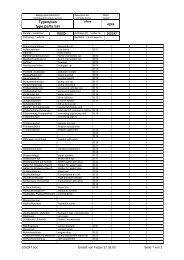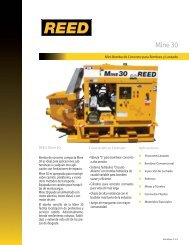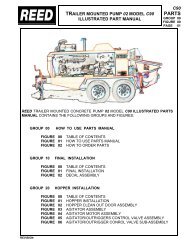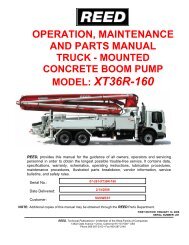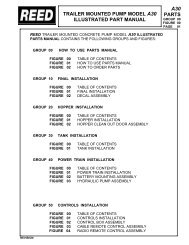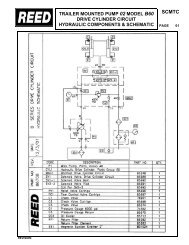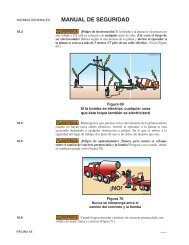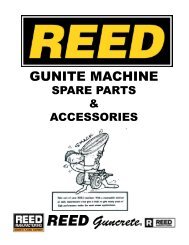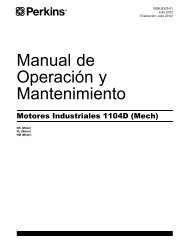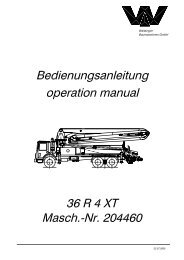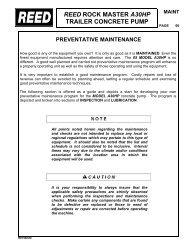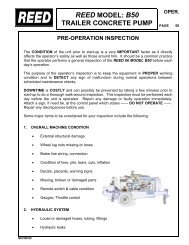Perkins Motor Operation and Maintenance Manual (English) - REED
Perkins Motor Operation and Maintenance Manual (English) - REED
Perkins Motor Operation and Maintenance Manual (English) - REED
You also want an ePaper? Increase the reach of your titles
YUMPU automatically turns print PDFs into web optimized ePapers that Google loves.
74 SEBU8325-01<br />
<strong>Maintenance</strong> Section<br />
Radiator - Clean<br />
9. Clean the cooling system filler cap. Inspect the<br />
cooling system filler cap's seals. Replace the<br />
cooling system filler cap if the seals are damaged.<br />
Install the cooling system filler cap.<br />
10. Start the engine. Inspect the cooling system for<br />
leaks.<br />
After cleaning the radiator, start the engine. Allow<br />
the engine to operate at low idle speed for three to<br />
fiveminutes.Acceleratetheenginetohighidle.This<br />
will help in the removal of debris <strong>and</strong> the drying of<br />
the core. Slowly reduce the engine speed to low idle<br />
<strong>and</strong> then stop the engine. Use a light bulb behind<br />
thecoreinorder to inspect the core for cleanliness.<br />
Repeat the cleaning, if necessary.<br />
Radiator - Clean<br />
i02335774<br />
Inspect the fins for damage. Bent fins may be opened<br />
with a “comb”. Inspect these items for good condition:<br />
Welds, mounting brackets, air lines, connections,<br />
clamps, <strong>and</strong> seals. Make repairs, if necessary.<br />
The radiator is not usually supplied by <strong>Perkins</strong>. The<br />
following text describes a typical cleaning procedure<br />
for the radiator. Refer to the OEM information for<br />
further information on cleaning the radiator.<br />
Note: Adjust the frequency of cleaning according to<br />
the effects of the operating environment.<br />
Inspect the radiator for these items: Damaged fins,<br />
corrosion, dirt, grease, insects, leaves, oil, <strong>and</strong> other<br />
debris. Clean the radiator, if necessary.<br />
Personal injury can result from air pressure.<br />
Personal injury can result without following proper<br />
procedure. When using pressure air, wear a protective<br />
face shield <strong>and</strong> protective clothing.<br />
Maximum air pressure at the nozzle must be less<br />
than 205 kPa (30 psi) for cleaning purposes.<br />
Pressurized air is the preferred method for removing<br />
loose debris. Direct the air in the opposite direction<br />
to the fan's air flow. Hold the nozzle approximately<br />
6mm(0.25 inch) away from the radiator fins. Slowly<br />
move the air nozzle in a direction that is parallel with<br />
the radiator tube assembly. This will remove debris<br />
that is between the tubes.<br />
Pressurized water may also be used for cleaning.<br />
The maximum water pressure for cleaning purposes<br />
must be less than 275 kPa (40 psi). Use pressurized<br />
water in order to soften mud. Clean the core from<br />
both sides.<br />
Use a degreaser <strong>and</strong> steam for removal of oil <strong>and</strong><br />
grease. Clean both sides of the core. Wash the core<br />
with detergent <strong>and</strong> hot water. Thoroughly rinse the<br />
core with clean water.<br />
If the radiator is blocked internally, refer to the OEM<br />
<strong>Manual</strong> for information regarding flushing the cooling<br />
system.<br />
i02678846<br />
Severe Service Application -<br />
Check<br />
Severe service is the application of an engine that<br />
exceeds the current published st<strong>and</strong>ards for that<br />
engine. <strong>Perkins</strong> maintains st<strong>and</strong>ards for the following<br />
engine parameters:<br />
• Performance such as power range, speed range,<br />
<strong>and</strong> fuel consumption<br />
• Fuel quality<br />
• <strong>Operation</strong>al Altitude<br />
• <strong>Maintenance</strong> intervals<br />
• Oil selection <strong>and</strong> maintenance<br />
• Coolant type <strong>and</strong> maintenance<br />
• Environmental qualities<br />
• Installation<br />
• The temperature of the fluid in the engine<br />
Refer to the st<strong>and</strong>ards for the engine or consult your<br />
<strong>Perkins</strong> dealer or your <strong>Perkins</strong> distributor in order to<br />
determine if the engine is operating within the defined<br />
parameters.<br />
Severe service operation can accelerate component<br />
wear. Engines that operate under severe conditions<br />
may need more frequent maintenance intervals in<br />
order to ensure maximum reliability <strong>and</strong> retention of<br />
full service life.<br />
Due to individual applications, it is not possible<br />
to identify all of the factors which can contribute<br />
to severe service operation. Consult your <strong>Perkins</strong><br />
dealer or your <strong>Perkins</strong> distributor for the unique<br />
maintenance that is necessary for the engine.



